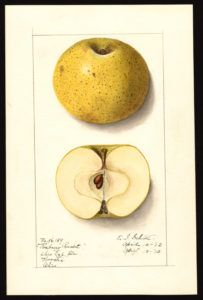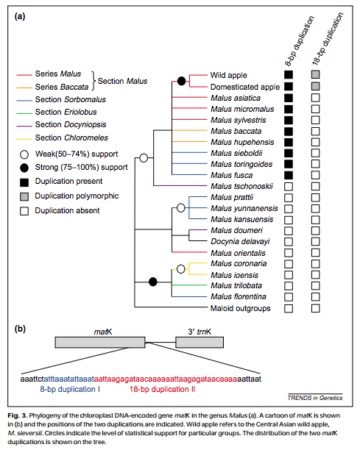- Recent demography drives changes in linked selection across the maize genome. Only a small part of teosinte contributed to maize.
- Changing year-round habitat use of extensively grazing cattle, sheep and pigs in East-Central Europe between 1940 and 2014: Consequences for conservation and policy. Animals don’t graze as much, or the same habitats, as they used to, which may not be altogether good for conservation of either plants or livestock because grazing was an important management intervention for thousands of years.
- Between China and South Asia: A Middle Asian corridor of crop dispersal and agricultural innovation in the Bronze Age. Wheat goes east, millets go west.
- Hybridization and extinction. Genetic swamping can happen, but hybridization can rescue a species too.
- Do European agroforestry systems enhance biodiversity and ecosystem services? A meta-analysis. Yes.
- Estimation of loss of genetic diversity in modern Japanese cultivars by comparison of diverse genetic resources in Asian pear (Pyrus spp.). The modern cultivars are variations on “Nijisseiki.”
Brainfood: Yam protection, Gleditsia distribution, Seed systems, Conservation narratives, Roselle diversity, Hassawi extinction, Apple GWAS, Dog domestication
- Disease risk perception and diversity of management strategies by farmers: The case of anthracnose caused by Colletotrichum gloeosporioides on water yams (Dioscorea alata) in Guadeloupe. Farmers gauge the disease pretty much the way scientists do, and use a diversity of mitigation measures, including diversity.
- Ghosts of Cultivation Past – Native American Dispersal Legacy Persists in Tree Distribution. “In the southern Appalachian region, honey locust distributions are more a reflection of Native American cultural practices.”
- Good year, bad year: changing strategies, changing networks? A two-year study on seed acquisition in northern Cameroon. In bad years, women call on extended networks.
- Conservation narratives in Peru: envisioning biodiversity in sustainable development. In terms of the relationship between conservation and development, there are biodiversity protectionists, traditionalists, localists, pragmatists, and capitalists.
- Diversity analysis based on agro-morphological traits and microsatellite based markers in global germplasm collections of roselle (Hibiscus sabdariffa L.). Nicely complementary datasets show that fibre type more diverse than calyx type.
- Extinction probabilities of Hassawi cattle from Saudi Arabia using Population Viability Analysis. Fancy maths gives it 20 years.
- Genome to Phenome Mapping in Apple Using Historical Data. Going back to old phenotype data in GRIN allowed identification of SNPs for color, fruit firmness, and harvest time.
- Genomic and archaeological evidence suggest a dual origin of domestic dogs. Independent domestications from different wolf populations in East Asia and in Western Europe, with the latter partially displacing the former.
Nibbles: Heirloom rice, Kava traditions, State turnip, Japanese paper, Potato Day, Madagascar invasion
- There’s Carolina Gold in them thar hills. Latest in a long list…
- Kava in the Pacific, island by island.
- A really ugly heirloom turnip is Vermont’s state vegetable. In other news, there are state vegetables.
- This video will make you want to make your own paper, I guarantee it.
- Oh come on, we missed Peru’s National Potato Day?
- Crop remains confirm Malagasy origins. But was Carolina Gold among them? Here’s the paper.
As American as apples
Gayle Volk and Adam Henk of USDA recently published a fascinating article on “Historic American Apple Cultivars: Identification and Availability.” Gayle kindly agreed to summarize it for us. Thanks, Gayle. Oh, and by the way, if you like old pictures of old apples (and other fruits), there’s a mesmerizing Twitter feed for you.

In this work, historic books, publications, and nursery catalogs were used to identify the cultivars that were propagated and grown in the United States prior to 1908. Synonyms, introduction dates, and source country for 891 historic apple cultivars were recorded in total. We then classified them based on their availability over time and popularity in nursery catalogs. We considered the highest priority cultivars for conservation to be those that were actively propagated and sold through multiple nurseries, as well as those that were grown and documented in more than one of the three time periods recorded (pre-1830, 1830-1869, and 1870-1907).
We found that, overall, 90% of the 150 highest priority cultivars are currently available as a result of conservation efforts in genebanks, private collections, and nurseries. Overall, it’s quite remarkable (and likely due in part to the longevity of apple trees) that these trees remain available, since the USDA National Plant Germplasm System Clonal Repository, where apple cultivars are conserved, wasn’t established until the 1980s. Cultivars that are not currently protected within genebanks but considered high priority were identified and suggested for inclusion in genebanks in the future. There were 51 high priority cultivars identified as possible additions to genebank conservation efforts, many of which may be available from the National Fruit Collection in Brogdale, England, and the Temperate Orchard Conservancy in Oregon.
This information will be useful for the many landholders who have historic apple trees on their properties. Identification efforts may make use of lists of historic cultivars to help determine identities based on either DNA fingerprinting or phenotypic traits.
The Adam and Eve of apples?
It was 1993 and US Department of Agriculture (USDA) horticulturist Phil Forsline flew over the magnificent mountain ranges of south-eastern Kazakhstan in a helicopter. Forsline had not been to the huge Central Asian country before; with the recent fall of the Soviet Union, this was his first chance to visit its wild forests. It was here, scientists now believe, that the ancestors of the apples sold in supermarkets around the globe originally evolved. Forsline was on a quest to find out what was really out there, in those mountain gardens.
The appearance on the BBC website of a long piece on the remarkable apple diversity of Kazakhstan and USDA’s efforts to conserve it, which leads with that mouth-watering paragraph above, reminded me that there was a much weirder little article a few weeks ago on much the same subject that I also wanted to point to. If only for the rhetorical flourishes it unleashes:
There are currently 7,500 varieties of apples in the world today — incredibly though, basically every single one of these can be traced back to a Mother and Father tree in a mysterious Kazakhstan forest.
…
In these Kazakh forests, bears, being the picky buggers that they are, would only pick and eat the sweetest apples.Then they’d go and wander around poop everywhere and the seeds of these sweet, delicious apples were spread around.
Then humans cottoned on and were all “hey, sick apples, bears – we’re gonna eat and grow these to stuff in our mouths as well.”
Then we started only growing these apples which is why out of the thousands of apple varieties that originated from these forests, only 15 of them end up in our grocery stores.
So now, thanks to a group of scientists’ gene sequencing magic, we know that 90% of all apples can be traced back to a Mama and Papa tree thousands of years ago – that was most likely eaten by a bear and then pooped out all over the place.
Very cool.
Incidentally, those bear-filled apple forests have recently been formally recognized with the International Carlo Scarpa Prize for Gardens. And of course they’re not new to the attentions of the popular scientific press. And the not so popular, all due respect to Steppe magazine.
But what you really want to know is where that assertion that all apple varieties can be traced to two trees comes from. Well, so did I, and I asked around, including the apple people at USDA. Nearest I can figure it, it may be based on the fact that an oldish paper looking at the taxonomy of apples found a wild accession in the USDA collection that shared a bit of chloroplast genome with many domesticated varieties. According to the abstract:
Two matK duplications were found, one in series Malus and the other in most M. domestica cultivars and one Central Asian M. sieversii accession.
Here’s what that looks like, from a different paper by the same authors with fancier graphics.

It’s all true about the bears though.
Over millions of years, millions of bears just prior to hibernation slowly and unconsciously selected the larger and sweeter fruits of the neo-apples. Bears do have a sweet tooth, as A. A. Milne noted in Winnie the Pooh. The relative inefficiency of a bear’s jaw in crushing fruit has another unintended consequence. As we have seen above, seeds that remain within the tissue (placenta) of the apple do not germinate. Herb Aldwinckle of Cornell University told me he has noticed that very small apples pass intact and uncrushed through a bear’s jaws and gut and, in one or two cases, were seen intact in the fecal mass. The seeds in the small intact fruits would not have germinated. It does not pay, in a genetic sense, to be a very small apple in the Tian Shan.
LATER: Oh, man, I forgot to link to Jeremy’s podcast.